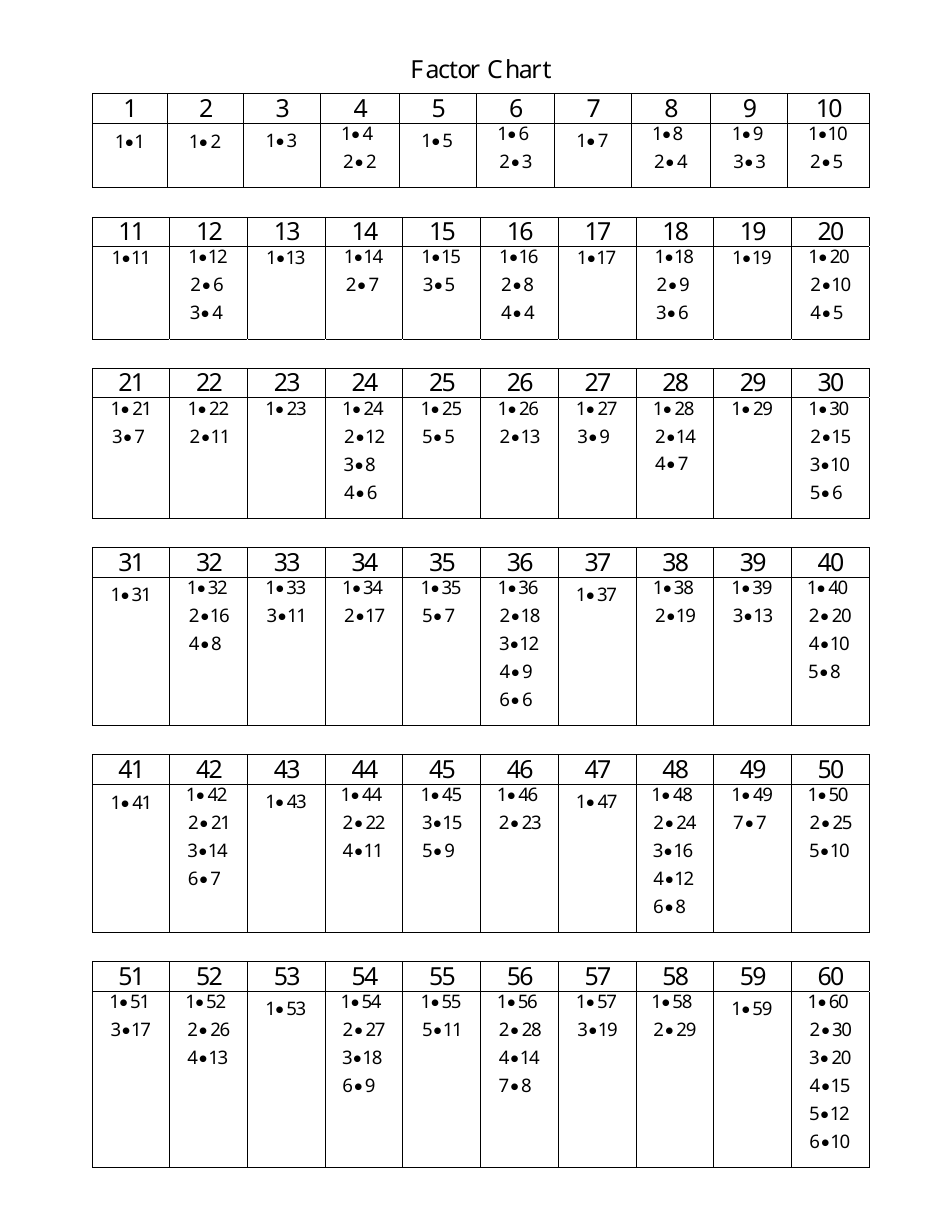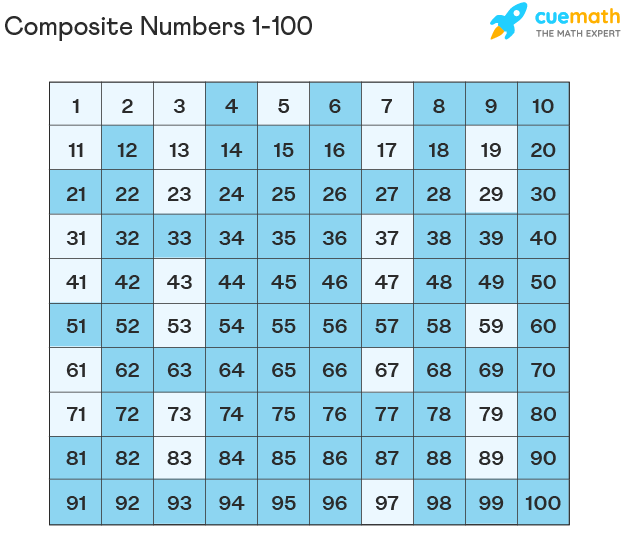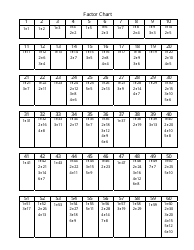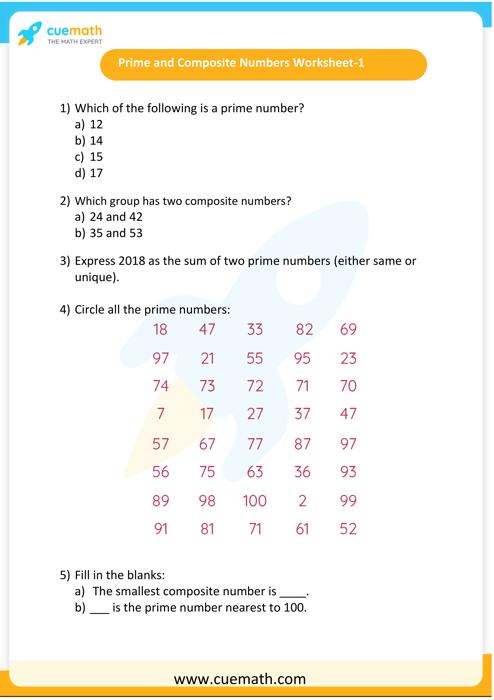What Number Has the Most Factors Between 1 and 100
1 is the only number between 1 and 100 that has too few factors to be a prime number. 3 4 12.

Factor Chart Prime Factorization Chart Quadratics Prime Factorization
Here are the factors not including negatives and some multiples for 1 to 100.

. So what we need to figure out is what number from 1 to 1000 has the most factors. 6 has 4 divisors. As defined by Merriam-Webster a factor is a number that divides evenly into another number.
What composite number between 1-100 has the most factors. So the answer for above query is 4 as it is the. One clever shortcut for counting the number of factors of a number is to look at its prime factorization.
To know about number with most factors one has to learn about highly composite number or anti prime number. It represents the sum of the proper divisors of n excluding n itself. 2 has 2 divisors.
The smallest prime number is 2 and the largest known prime number is 2 82589933 1. 60 72 84 90 and 96. The original numbers are factors of the product number.
101 rows Lets find factors of all numbers from 1 to 100 and check whether they areprimeor. A prime number has only two factors itself and 1. SN is the Restricted Divisor Function.
For non-primes I would first write the number as a product of primes. For instance since 1000 23 53 any factor of 1000 has to have 20 21 22 or 23 in it 4 choices and 50 51 52 or 53 in it 4 choices. However 10 is not an example of a prime number because 10 has two more factors namely 5 and 2 other than itself and 1.
What are the multiples of 10000. 8 has 4 divisors. A highly composite number sometimes called anti-prime is a positive integer with more divisors than any smaller positive integer has.
L 1 R 10. 5 has 2 divisors. A common factor is a factor that is shared.
For instance 48 163 2 4 3 1. They each have a total of 12 factors including the number one and the number itself. Thus for 12 12 2x2x3 From this.
1 2 4 5 10 20 25 50 100. CountdN is the number of positive divisors of n including 1 and n itself. Factors of 25 are 1 5 and 25.
101 rows More Table of FactorsPrime Factors and Multiples. The Greatest Common Factor of 1 and 100 is 1. Factors of 9 are 1 3 and 9.
The related concept of largely composite number refers to a positive integer which has at least as many divisors as any smaller positive integer. 9 has 3 divisors. If a x b c then a and b are factors of c.
This is the most basic form of a factor but algebraic expressions can also be factored though that is not the intent of this calculator. 60 72 84 90 and 96 each have twelve factors. Factors of 4 are 1 2 and 4.
Also 1 and 16 are factors of. Sanika and Amy both said that the number under 1000 with the most factors is 840 32 factors. We know 2 and 8 are factors of 16 because 2 x 8 16.
For example primes like 3 have only two factors 3 and 1. Factors of 49 are 1 7 and 49. We know that the numbers between 1 and 100 which have exactly three factors are 4 9 25 and 49.
The maximum number of different factors is 12 and there are 5 numbers in 1-100 which have 12 factors. Sanika found the smallest number with exactly 100 factors. The name can be somewhat misleading as two highly composite numbers 1 and 2 are not actually.
4 has 3 divisors. Say you wanted to find the factors of 16. Prime Factors of 1Prime Factors of 1002 2 5 2.
Using 12 as an example in addition to 3 and 4 being factors. The following numbers under 100 have the most factors. 7 has 2 divisors.
You would find all pairs of numbers that when multiplied together resulted in 16. Positive integers that divides 10000 without a remainder are listed below. The number less than 100 that has the most factors is thus the largest power of 2 less than 100 which happens to be 64.
σN is the Divisor Function. 4 is a factor of 16 because 4 x 4 16. 1 3 9 11 33 99.
Number 6 has most factors between 1 10. In this case you get 48 2 4 3 1 and 4111 10 so 48 has 10 factors 1 2 4 8 163 6. What is a common factor.
108 126 132 140 150 156 160 198. Likewise 840 is the number with most factor between 1 1000. What number has the largest number of factors from 1-100.
Similarly number 60 has most factor between 1 100. You then add 1 to each exponent and take the product of the resulting numbers to get the number of factors of N. Prime factorising 100 gives us 2times2times5times5 now we can assign the smallest prime bases to the largest powers which will give us 2 4 times3 4 times5times7 45360.
1 has 1 divisor. To find the number of factors of a number N you write N as a product of distinct primes powers. Positive integers that divides 10000 without a remainder are listed below.
1 2 7 14 49 98. 1 to 50 Factor Prime Factor. I think that you just have to list the numbers from 1 to 25 and their factors.
7 is an example of a prime number because it can only be perfectly divided by 1 and 7. It represents the sum of all the positive divisors of n including 1 and n itself. Which are the numbers between 100 and 200 with 12 factors.
10 has 4 divisors. 3 has 2 divisors. 1 2 3 4 6 8 12 16 24 32 48 96.
The prime numbers until the next cumulative product is greater than 100 - in this case 23530 is the number that has the most unique factors. The biggest factor of 10000 is 5000. It is possible for a number to have multiple factors.
If the factors must be unique then we simply use 2 3 5 etc. The Integers 1 to 100.

1 100 Factor Chart Download Printable Pdf Templateroller

Composite Numbers From 1 To 100 List Chart Odd And Even Composite Numbers Examples

1 100 Factor Chart Download Printable Pdf Templateroller

Composite Numbers From 1 To 100 List Chart Odd And Even Composite Numbers Examples
Comments
Post a Comment